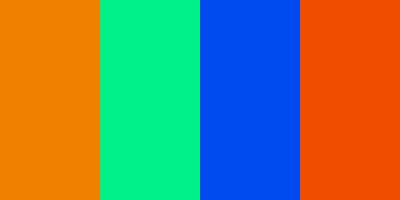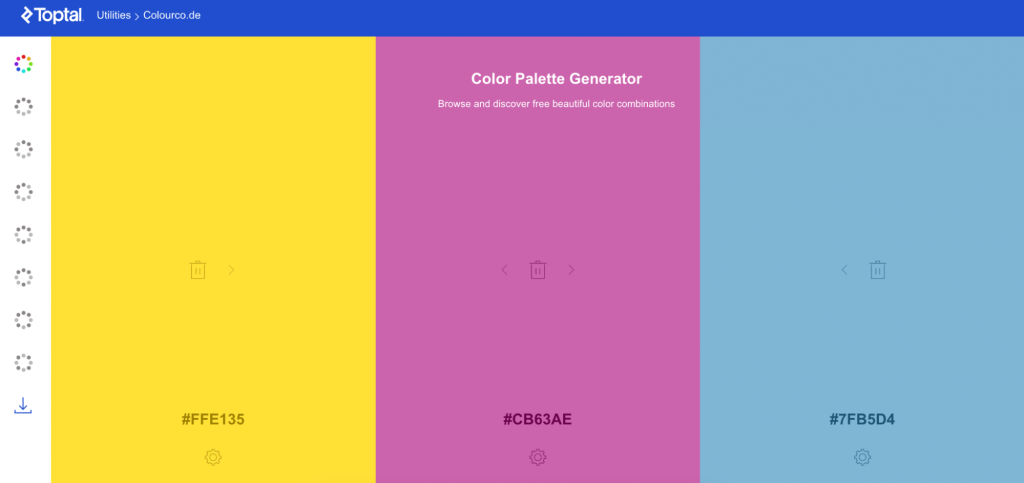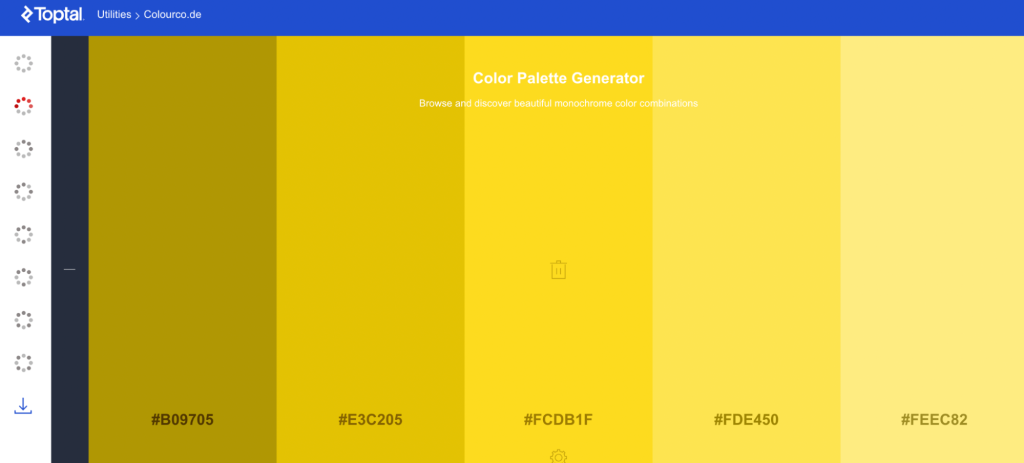Looking for the perfect website colour palette? Read this guide to understand our practical 6-step framework to find the most effective colour combinations for your brand.
When it comes to designing a website, the colours you choose have a critical role to play.
Colours don’t just ensure that your website looks good. They also define the brand identity, establish a connection with your target audience, and—most importantly—ensure that your website is user-friendly and accessible.
That’s a lot of boxes to tick, and choosing a website colour scheme can feel like a daunting task. But, with our framework, you’ll find that you’re just six steps away from finding the perfect colour palette.
If you’re looking for a practical, easy-to-follow guide, then you’re in the right place. Keep reading to uncover:
- The importance of choosing the right colour palette for your website
- A recap of basic colour theory
- The 6 types of website colour palettes
- How to choose the right website colour palette: A step-by-step guide
- The best colour palette tools to help you choose
First up: why your website colours matter.
The importance of choosing the right colour palette for your website
Choosing a colour palette for your website isn’t just a matter of aesthetics. Sure, you want your website to look great—but you also want it to be accessible, easy to navigate, and an all-round delight to use.
You also want your website to speak volumes about your brand; when people view and use your website, they should get a strong sense of your brand personality and values. Using a website color palette generator can help you explore different options and ensure your chosen colours align with your brand identity.
Let’s take a closer look at the role of colour in effective web design.
Your website colours convey your brand identity
Your website colours form the basis of your brand identity. In fact, your chosen colours influence every other aspect of your visual brand—including your logo and website typography, which will all be designed and styled with your colour scheme in mind.
When you choose your colour palette, you want to accurately capture what your brand is all about. Are you playful and uplifting? Serious and professional? Luxurious and elegant? Your brand personality and values will all be conveyed through your website colour palette.
And, because your chosen colour scheme will be applied consistently wherever your brand has a presence, it will help to build recognition among your target audience. When you think of Starbucks, you immediately envision that earthy green and white colour palette. The name “McDonald’s” instantly brings red and yellow to mind. That’s how powerful colour is for branding—and website colours are no exception.
The right colour scheme ensures accessibility and usability
Usability and accessibility are of utmost importance when designing a website. You want important features to stand out—such as call-to-action buttons and site menus—and you want all text to be legible.
Colour plays a crucial role in shaping the user experience (UX) design; that is, the overall ease, usability, and user-friendliness of your website. An appropriate colour palette for website design considers contrast and legibility, ensuring that all text is easily readable and accessible.
Ultimately, if you want to design a website that’s usable, inclusive, and accessible, you must choose your website colours with care.
Your website colours build an emotional connection with your audience
Depending on the kind of product or service you’re offering, you want to create a website that evokes the right mood and tone. A jolly, playful colour palette might feel out of place on a high-tech security website—just as a black and white colour scheme would convey an unexpected air of seriousness on a website selling children’s books.
In order to resonate with your target audience, you want them to feel a certain way when they interact with your website—and colour can help you achieve that. It’s important to incorporate colour psychology (how different colours make us feel) and choose your website colours accordingly.
There’s no getting around it: effective website design relies on smart colour choices. And smart colour choices require an understanding of colour theory—so let’s go over that next.

A recap of basic colour theory
You’ll find a complete introduction to colour theory here, so we won’t go into too much detail right now. We’ll just recap on the basics as they relate to the task at hand: choosing your website colour palette.
Colour theory is the study and application of colour. It’s both a science and an art (with a dash of psychology thrown in!) that tells us how different colours relate to and interact with each other.
This is useful because it shows us how different colour combinations can be used to achieve different visual effects—such as contrast, harmony, and balance.
We can understand the relationship between different colours by looking at the colour wheel. The colour wheel is a circular diagram showing the three primary colours, the three secondary colours, and the six tertiary colours as well as their various shades, tints, and tones (i.e. lighter and darker variations).
Colours that are opposite each other on the colour wheel are complementary—that is, they achieve high contrast when used together. Colours that are close to each other on the colour wheel are harmonious—creating a sense of balance and flow.
Once you know your way around the colour wheel, you’ll have a good sense of how different colours work together. Useful stuff when choosing your website colour palette!
The 6 types of website colour palettes
The different relationships and colour combinations we get from the colour wheel are known as colour palettes (or colour schemes). There are six main types: monochromatic, analogous, complementary, split-complementary, triadic, and tetradic.
Monochromatic colour palettes—best for elegance and simplicity

Monochromatic colour schemes are based on just one hue and several variations of that same hue. This type of colour palette is ideal for achieving a simple, elegant, and sophisticated look. However, monochrome colour schemes don’t offer high contrast—and may therefore pose a problem when it comes to legibility and accessibility (especially in web design).
Analogous colour palettes—best for harmony and flow

Analogous palettes are the most harmonious of colour schemes, comprising colours that are next to or near each other on the colour wheel. The overall effect is one of balance and flow. Just like monochromatic colour palettes, analogous schemes are low on contrast. Something to bear in mind as you choose your website colours!
Complementary colour palettes—best for contrast and “pop”

Complementary colour schemes are based on opposing colours—that is, colours that are opposite each other on the colour wheel. These colour palettes are striking and bold and great for creating contrast.
Split-complementary colour palettes—best for contrast and balance

Split-complementary palettes are based on three main colours: a base hue and the two colours that sit on either side of its complementary (i.e. opposite) colour on the colour wheel. Split-complementary colour schemes strike the sweet spot between contrast and harmony.
Triadic colour palettes—best for energy and dynamism

Take three colours that are evenly spaced around the colour wheel and you’ve got yourself a triadic colour palette. These colour schemes are well-balanced and dynamic, offering a visually exciting and aesthetically pleasing composition.
Tetradic colour palettes—best for versatility and depth

Tetradic colour palettes comprise two pairs of complementary colours. Tetradic colour schemes are rich and vibrant, ideal for adding depth to your website design. And, because they use four colours, there’s plenty of versatility with this type of colour scheme.
For a more comprehensive introduction to colour schemes, check out this post: A Complete Guide to Colour Palettes and How To Use Them (With Examples).
Are you ready to choose the perfect colour palette for your website? Let’s get to it!
How to choose the right website colour palette: A step-by-step guide
There are 6 key steps to choosing a website colour palette:
- Understand the brand and target audience
- Gather inspiration
- Determine what type of colour scheme you’ll use
- Choose your dominant, secondary, and accent colours
- Check your colour palette against web accessibility guidelines
- Test your website colour palette
Now let’s put them into practice!
1. Understand the brand and the target audience
There are two initial considerations to make when choosing a website colour palette:
What is the brand identity you’re trying to convey?
How do you want your target audience to feel when they perceive your website colours?
If you don’t have existing brand guidelines in place, think about what your brand represents, the values it embodies, and what kind of industry it’s competing in. It can be helpful to come up with a word map here—a simple brainstorm of all the different adjectives that come to mind when you think of the brand.
For example: if you’re designing a website for a theatre company that offers drama, dance, and singing classes to young children, you might describe the brand personality as creative, fun, inspiring, and energetic. To describe the brand values, you might use words like inclusive, educational, nurturing, and empowering.
Now do the same for your target audience. Who are they and what kind of feelings do you want to inspire in them when they look at your website?
In the case of our children’s theatre school, your target users are probably parents who are thinking about enrolling their kids in a class. You’d want them to feel excited and inspired. And, at the same time, you’d want to evoke a sense of credibility, confidence, and trust.
With a clear picture of the brand identity you want to convey and the audience you want to connect with, you can start thinking about potential colours. Use colour psychology here—research what kinds of colours tend to be associated with the values and emotions you’ve come up with.
2. Gather inspiration
You’ve probably got some colours in mind now—but don’t worry if you’re still working from a blank canvas. This next step in the process is all about getting inspired and exploring different colour combinations.
At this stage, it’s worth conducting some competitor research. What similar companies and brands are competing in your niche, and what colour palettes do they use? What do you like and dislike about your competitors’ colour schemes?
You’re not limited to your competitors, though. Look to magazines, billboards, product packaging, and books for inspiration—any kind of art or graphic design work that evokes the kind of mood and tone you’re trying to create with your own website colours.
At the same time, explore the colour wheel and experiment with online colour palette tools to see what combinations are possible (we share some tool recommendations at the end of this post). Perhaps you love the idea of incorporating yellow into your colour scheme. So, try out different shades of yellow and consult the colour wheel—and online tools—to see what colours harmonise and contrast with the various shades.
Let’s say you like banana yellow. Google will tell you that the hex code for banana yellow is #FFE135, which you can put into a colour palette generator tool like this one from Toptal.
From there, you can explore different colour pairings and palettes based on your chosen colour.


Hopefully this exploration phase will leave you with some definitive answers: colours you absolutely want to avoid for your website, and some potential colour combinations that you think could work well.
3. Determine what type of colour scheme you’ll use
As you explore different colours and colour combinations, you may already find yourself leaning towards a particular type of colour scheme. Perhaps your favourite colour pairings so far are complementary and high-contrast—or maybe you find yourself drawn to more harmonious combinations.
While you don’t need to strictly box yourself into a specific colour scheme, it helps to refer back to the different types of colour palettes and the visual effects they achieve.
Monochromatic and analogous colour palettes are great for achieving balance and harmony, but they can limit you in terms of contrast. Complementary and split-complementary schemes are ideal for creating high-contrast palettes that pop, while triadic and tetradic schemes offer something in between.
The type of colour scheme you go for will depend on your brand personality and values. If you’re looking to convey a sense of simplicity and elegance, you’ll likely want a more harmonious palette. If your brand is energetic and playful, you’ll want something more dynamic and vibrant.
With your brand values from step 1 in mind and your colour inspiration from step 2, start thinking about what type of colour palette is best suited to your website. If you’re not sure, continue experimenting—try your favourite shades in different combinations and see where you land.
4. Choose your dominant, secondary, and accent colours
Regardless of what type of colour scheme you opt for, you won’t apply all the colours in that scheme evenly across your website. Some colours will feature more prominently, while others will provide an accent here and there.
When thinking about how you’ll apply your colour palette, you can follow the 60-30-10 rule. This is a popular web design principle that helps to achieve balance with your chosen colours. It stipulates that:
- 60% of your website will be made up of your dominant colour;
- 30% will comprise a secondary colour—usually one that complements (and contrasts with) your dominant colour;
- 10% of your website will be made up of your accent colour. Your accent colour is used sparingly yet strategically to draw attention to certain elements and create an interesting visual pop.
While you don’t need to follow this rule right down to the last percentage, it does help to think of your colours in that approximate split.
With that in mind, it’s time to choose your dominant, secondary, and accent colour(s). As you do so, keep the brand identity and the target audience firmly in focus. Remember what you’re trying to convey and who you’re conveying it to.
If you’ve got a few different colours in mind but aren’t sure how to distribute them as per the 60-30-10 rule, experiment with different combinations. If you’re using a website builder tool, play around with the colour palette settings to see which distribution works best for your chosen colours. If you’re building a website from scratch, you can create some quick prototypes to try out the colours in action.
5. Check your colour palette against web accessibility guidelines
With your dominant, secondary, and accent colours decided you’ve essentially landed on your website colour palette—exciting stuff! But before you get carried away and start applying your colour palette, there’s one more box to check. And it’s an important one!
A great website is not just beautiful. It’s also user-friendly and accessible for everybody, including people with disabilities. Colour has a major impact on accessibility, so it’s important to check your website colour palette against Web Content Accessibility Guidelines (WCAG) as set out by the World Wide Web Consortium (WC3).
You can use a contrast checker tool like this one to check whether your chosen colour combinations provide sufficient contrast. You’ll be given a contrast ratio score and an indication as to whether your score is acceptable according to accessibility guidelines.
If your website’s colour palette doesn’t meet accessibility standards, you must go back and adjust it. Without sufficient contrast, your website will be unpleasant at best and inaccessible at worst. A complete no-go either way!
6. Test your website colour palette
Assuming your colours passed the contrast check, it’s time to test your website colour palette in action. In other words, start building your website and see how your colour palette stacks up!
Start with the website homepage. Once you’ve got all the main content filled in, imagine perceiving your website as a customer or user. How do the colours make you feel? Does your colour palette convey the brand as you intended? Does it draw attention to important elements? Is everything clear and legible?
If you can, it’s well worth getting multiple perspectives. Put the homepage (or your prototypes) in front of colleagues or key stakeholders and ask them to review it. What does the colour palette say to them about the brand? Do they find the composition harmonious and visually pleasing or does it need some adjustments?
If your website colour palette gets the seal of approval, you can proceed to apply it throughout your website. If it’s not quite right, experiment and adjust accordingly until you’ve got it just perfect. Your website colour palette is incredibly important, so don’t shy away from taking plenty of time and care with it.
Now let’s explore some of the best tools to help you find the perfect colour palette!
The best colour palette tools to help you choose
The colour wheel is an excellent starting point when choosing a website colour palette, but online tools can make your research much more fun and interactive—not to mention quicker! Here are some of the best free colour palette tools to help you find the perfect colour scheme:
- Adobe Color: an interactive colour wheel that you can click on or drag to select colours and identify their harmonious and complementary combinations.
- Toptal colour palette generator: select what kind of colour scheme you want to create from the sidebar (monochromatic, analogous, triadic, etc.) and see what the generator suggests. Alternatively, you can input different hex codes and build a colour palette from scratch.
- Image Color Picker: An excellent tool if you’ve seen a colour you like and want to find the hex code. You can screengrab the colour or colours you want, upload the screenshot, and the picker tool will give you the hex codes. Handy!
- Randoma11y: roll over different colours in the palette to see them in action, and keep clicking on a particular hue to generate different shades and combinations. For every colour scheme, you’ll get the hex codes and a contrast ratio score as per Web Content Accessibility Guidelines.
Next Steps
Now that we’ve given you a walkthrough of how colour palettes impact website design, you might be interested to know how graphic design uses the concept, as well.
To further understand the graphic design space and its usage of colour, you could also consider some of our other resources:
- Watch this session by design veteran and AND’s Academic Head, Prachi Mittal, and our Course Lead, Soumya Tiwari.
- Talk to a course advisor to discuss how you can transform your career with one of our courses.
- Pursue our Graphic Design courses – all courses are taught through live, interactive classes by industry experts, and some even offer a Job Guarantee.
- Take advantage of the scholarship and funding options that come with our courses to overcome any financial hurdle on the path of your career transformation.
Note: All information and/or data from external sources is believed to be accurate as of the date of publication.









